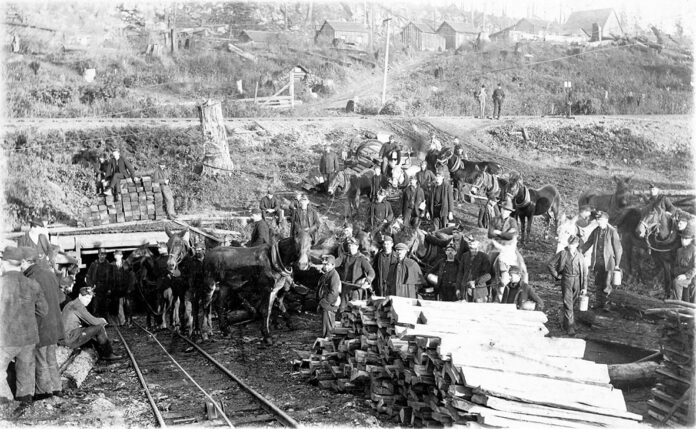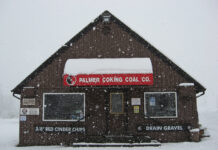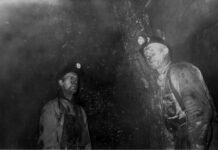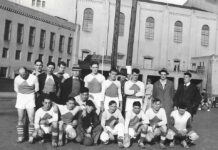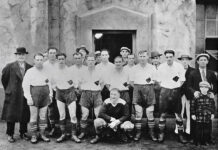Last week’s column highlighted the coal mine that Eugene Lawson opened on the rich seam of McKay coal that was simultaneously mined in nearby Black Diamond and Franklin. Though the mine produced a superior grade of bituminous coal, the operation was challenged by explosive methane gas that claimed the lives of 11 men on Oct. 1, 1902, and another 16 miners on Nov. 6, 1910, after which the operation was permanently closed.
The Old Lawson Mine was located at approximately 26000 Old Lawson Road. The Columbia & Puget Sound Railroad tracks that connected Black Diamond to Franklin can be seen just above the mine’s portal. The mine employed mules to pull coal carts within the mine. An electric hoist, shaped like a giant fishing reel and spooled with steel cable, pulled coal carts to the surface. The hoist’s cable rests on a roller between the two rails. The pile of lumber in front of the large group of miners and mules was called lagging and used to hold up the mine’s ceiling. Housing for the predominantly Austrian and German miners who worked at Old Lawson are visible above the railroad.
The Lawson Mine operated for just over 15 years and produced more than 1.1 million tons of coal, averaging 74,600 tons per year. Yet, during that period Lawson experienced 34 fatalities, making it by far the region’s most dangerous and probably the deadliest coal mine in the state. Lawson recorded 33 deaths per million tons mined compared to nearby Mine #11’s eleven deaths and Mine #14’s four deaths per million tons mined.
As for Eugene Lawson, after selling his mine holdings to Pacific Coast Coal Company in 1899, he had an interesting second act. In 1901, he was cited as an accessory in a case of bankruptcy fraud after taking possession of 80 city lots in east Seattle deeded to him by D.N. & Lizzie Holden who were trying to evade property forfeiture by bank foreclosure.
Two years later in August 1903, Lawson was retained by the Black Diamond Coal Mining Co. (BDCMC) to broker a sale of their operations to Pacific Coast Coal Co. Lawson and two associates, Bruce Cornwall and Maurice McMicken were authorized by BDCMC to sell the business for $1.5 million, after which a deal was struck. However, Black Diamond’s President, H.H. Taylor, and its major shareholder, D.O. Mills butted in, initiating direct negotiations with John D. Farrell of Pacific Coast that resulted in an inexplicable price reduction to $1.1 million. The sale closed in June 1904 as Pacific Coast vastly expanded its coal mining footprint.
Lawson sued for his 5% commission amounting to $55,000, but BDCMC refused to pay. The case dragged on for five years and twice reached the Washington Supreme Court. In June 1909, Lawson was awarded $66,935 in commission and damages. The court held that Black Diamond Coal Mining Company owed him the commission and that through poor negotiations BDCMC squandered perhaps $400,000 when renegotiating the original deal.
Eugene Lawson soon started a well-drilling company. In 1911, Lawson undertook a search for coal near the Green River. His exploratory drill hole penetrated 1,403 feet deep and discovered at least seven coal seams in the Kummer series. Natural gas was encountered between the 900 and 1,000-foot levels.
After his Green River drill hole was abandoned, pressurized water began bubbling to the surface yielding significant amounts of coal-bed methane gas. When ignited the gas caused flames to burst high into the air and the site became known as Flaming Geyser. A privately owned resort sprung up and operated for decades. A later attempt to enlarge the geyser failed and restricted the gas flow thereby reducing the flame to something resembling a BIC lighter. The property was eventually acquired by Washington and became the popular Flaming Geyser State Park.
Lawson was born in Monroe County, Kentucky in 1857 to Tyre and Mary (Johnson) Lawson. He never married, living most of his life in Seattle boarding houses and later hotels. Eugene Francis Lawson died on Aug. 26, 1937, at age 80, having resided in the Stevens Hotel at First Ave. and Marion Street for decades. His prostate condition probably contributed to a urinary tract infection from which he died. He was survived by a sister, Mrs. M.E. Boozer, and a nephew, Frank R. Lawson, who wrote the short obituary appearing in Seattle newspapers.
This Black Diamond Historical Society photo #97.1.26 of the Old Lawson Mine was preserved by Frank Guidetti, a photographer who captured and retained many historic images. It was likely taken between around 1900. Biographical information about Eugene Francis Lawson was provided by Donna Brathovde, a Ravensdale historian and genealogist. Next week story – a bowling alley photo at Old Lawson provided to the Museum by John “Cut” Kravagna.

